
Cast * Interesting Facts * Trivia * Making Of * Will there be another Roger movie? * Interviews with creator Gary Wolf

Cast * Interesting Facts * Trivia * Making Of * Will there be another Roger movie? * Interviews with creator Gary Wolf
Directed by: Robert Zemeckis
Written by: Gary K.
Wolf (novel) & Jeffrey Price
Music by: Alan Silvestri
Released on: June 21, 1988
Running Time: 103 minutes
Budget: $50 million
Box-Office: $154 million in the U.S.,
$349 million worldwide
Roger Rabbit/Benny the Cab/Greasy/Psycho... Charles
Fleischer
Eddie Valiant... Bob Hoskins
Jessica Rabbit... Kathleen Turner (acting), Amy Irving (singing),
Betsy Brantley (performance model)
Judge Doom... Christopher Lloyd
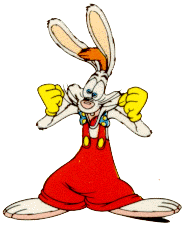 Dolores...
Joanna
Cassidy
Dolores...
Joanna
Cassidy
Bugs Bunny/Daffy Duck/Porky Pig/Sylvester/Tweety... Mel Blanc
Marvin Acme... Stubby Kaye
Donald Duck... Tony Anselmo
R.K. Maroon... Alan Tilvern
Lt. Santino... Richard Le Parmentier
Baby Herman... Lou Hirsch
Raoul J. Raoul... Joel Silver
Augie... Paul Springer
Angelo... Richard Ridings
Arthritic Cowboy... Edwin Craig
![]() This movie took
8 years to be completed--its development started in 1980.
This movie took
8 years to be completed--its development started in 1980.
![]() In one of the
many versions of the movie's script, a not-quite-so-voluptuous Jessica
was supposed to be the villain and looked a lot like Cruella De Vil-gone-Hollywood.
In one of the
many versions of the movie's script, a not-quite-so-voluptuous Jessica
was supposed to be the villain and looked a lot like Cruella De Vil-gone-Hollywood.
![]() Warner Bros. insisted
that Bugs Bunny only appear in scenes where he performed directly opposite
Mickey Mouse, and had the same exact number of words of dialogue that Mickey
did. Warners' insistence on a similar arrangement for Donald and Daffy
Duck resulted in their loony dueling pianos rendition of the "Hungarian
Rhapsody."
Warner Bros. insisted
that Bugs Bunny only appear in scenes where he performed directly opposite
Mickey Mouse, and had the same exact number of words of dialogue that Mickey
did. Warners' insistence on a similar arrangement for Donald and Daffy
Duck resulted in their loony dueling pianos rendition of the "Hungarian
Rhapsody."
![]() According to producer
Don Hahn, "the first Who Framed Roger Rabbit screening was a disaster.
People walked out. They recruited an audience of a date-night crowd. The
audience wasn't sure what the movie was, because it was unfinished."
According to producer
Don Hahn, "the first Who Framed Roger Rabbit screening was a disaster.
People walked out. They recruited an audience of a date-night crowd. The
audience wasn't sure what the movie was, because it was unfinished."
![]() Who Framed
Roger Rabbit won 4 Academy Awards: for Best Sound Effects Editing,
Best Visual Effects, Best Film Editing, and a Special Achievement Award
for animation direction and creation of the cartoon characters.
Who Framed
Roger Rabbit won 4 Academy Awards: for Best Sound Effects Editing,
Best Visual Effects, Best Film Editing, and a Special Achievement Award
for animation direction and creation of the cartoon characters.
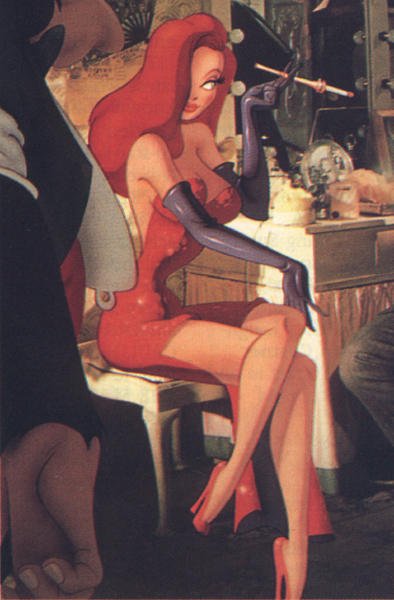
![]() Terry Gilliam considered directing this movie, but decided it would be
too difficult.
Terry Gilliam considered directing this movie, but decided it would be
too difficult.
![]() Jessica Rabbit's
speaking voice was performed by Kathleen Turner, and her singing voice
was performed by Amy Irving. Turner was uncredited.
Jessica Rabbit's
speaking voice was performed by Kathleen Turner, and her singing voice
was performed by Amy Irving. Turner was uncredited.
![]() "The type of animation
that was needed was beyond what we would do at Disney normally," animator
Andreas
Deja explains. "This was to be much broader, and Roger Rabbit was to
be a much more physical character, expressing himself more physically.
He’s put together in a very surreal way too--he could squash and stretch
a lot more. That part was actually fun, because I think it loosened me
up--my animation got a lot looser after Roger Rabbit. Before that I was
very much into the drawing and making sure the arc’s just right and into
the technicalities. But when I saw the rabbit, the one that Dick designed,
I thought this doesn’t look like it’s going to be any drawing problems,
which it really wasn’t. Even though there are different Rogers in the movie
because every animator draws a little differently, with a broad character
like that, it’s really not that visible unlike any kind of human character.
Drawing-wise it was easy--you could just go to town and use your animation
principle to the fullest and really loosen up. Just plugging that into
the live-action and making sure that’s perfect was sometimes a pain."
"The type of animation
that was needed was beyond what we would do at Disney normally," animator
Andreas
Deja explains. "This was to be much broader, and Roger Rabbit was to
be a much more physical character, expressing himself more physically.
He’s put together in a very surreal way too--he could squash and stretch
a lot more. That part was actually fun, because I think it loosened me
up--my animation got a lot looser after Roger Rabbit. Before that I was
very much into the drawing and making sure the arc’s just right and into
the technicalities. But when I saw the rabbit, the one that Dick designed,
I thought this doesn’t look like it’s going to be any drawing problems,
which it really wasn’t. Even though there are different Rogers in the movie
because every animator draws a little differently, with a broad character
like that, it’s really not that visible unlike any kind of human character.
Drawing-wise it was easy--you could just go to town and use your animation
principle to the fullest and really loosen up. Just plugging that into
the live-action and making sure that’s perfect was sometimes a pain."
![]() Bob Hoskins watched
his young daughter to learn how to act with imaginary characters. He later
had problems with hallucinations. Hoskins' son was reportedly furious that
his father hadn't brought any of his cartoon co-stars home to meet him.
Bob Hoskins watched
his young daughter to learn how to act with imaginary characters. He later
had problems with hallucinations. Hoskins' son was reportedly furious that
his father hadn't brought any of his cartoon co-stars home to meet him.
![]() A shot, allegedly
animated by two Disney practical-jokers (who were subsequently fired),
of Jessica's vagina during her dance sequence was inserted into the first
laserdisc print.
A shot, allegedly
animated by two Disney practical-jokers (who were subsequently fired),
of Jessica's vagina during her dance sequence was inserted into the first
laserdisc print.
![]() There are persistent
rumours that the laserdisc edition of this film has a few frames of Jessica
Rabbit with no panties, visible when she and Eddie are thrown out of the
cab. The infamous scene has been altered for the DVD version: Jessica
now has white panties on.
There are persistent
rumours that the laserdisc edition of this film has a few frames of Jessica
Rabbit with no panties, visible when she and Eddie are thrown out of the
cab. The infamous scene has been altered for the DVD version: Jessica
now has white panties on.
![]() "At the time,
it was like wading through a dark cave without a lantern," producer Don
Hahn recalled in a March 2003 interview. "We had the [exterior] shoot
in Los Angeles, but we shot most of the interiors in London. We had the
animation studio in London, and then Industrial Light & Magic [the
special-effects house] was in Northern California. So the geography of
it was difficult. And then the budget was astronomical. It was like $30
million. We would get phone calls to stay on track. Plus it was unknown
territory. There was so much animation. It was like making a complete live-action
movie and a complete animation movie at the same time. There were no computers.
It wasn’t that long ago--15 years ago--but there were no computers in the
show. It is a one-of-a-kind movie It was drawn by hand and painted by hand
and composited on optical printers at ILM by hand, so that made for a cumbersome
project. And Zemeckis was and is a pretty brave and visionary guy. I have
to point to Bob and say that it was his movie and his bravery that led
us all to Roger Rabbit. He didn’t want to limit Roger Rabbit to the traditional
rules of animation live-action combinations, such as you would never move
the camera, and you would never want to have an animated character interact
that much with a human. He just threw all those rules away, so that when
you walk into the room, if a toon picks up a pencil, it should be a real
pencil, and if he drives a car, it should be a real car in an extremely
interactive environment. The camera should move, so you feel it. All those
things made it extremely challenging to work on the movie. Nobody’d ever
done that to that degree. It was also like making two movies. There was
a live-action movie and there was a whole animated feature that played
on top of it. I think all those things were difficult at the time. The
technique would probably be easier [today] because with computer graphics
and compositing the way it is now, there’s a lot more latitude to put things
together and control them than there was back then. It’s funny, because
the movie has a very 'hand-done' feeling to it, not only in the animation,
but in the cinematography and other areas. It looks very '1940s' and warm
and hand-done. That’s something that computer graphics may never purely
have. I’m not sure you’d do a CG version of Roger Rabbit, as part of the
charm of it is that it looks like it just popped off the pencil of a Tex
Avery or a Richard Williams. It feels very hand-done, so I think that even
though computers could help us a huge deal to photograph and composite,
I’m not sure that technique-wise you’d ever want to go to that side of
Roger. I think part of the charm of it is that they’re toons. Animation
was nothing at the time. People were making animated films, but it wasn't
the big blockbuster, money-making thing it has become since. So it was
a little bit of a flier to say let's make a movie to celebrate all the
old toons and all the old animation."
"At the time,
it was like wading through a dark cave without a lantern," producer Don
Hahn recalled in a March 2003 interview. "We had the [exterior] shoot
in Los Angeles, but we shot most of the interiors in London. We had the
animation studio in London, and then Industrial Light & Magic [the
special-effects house] was in Northern California. So the geography of
it was difficult. And then the budget was astronomical. It was like $30
million. We would get phone calls to stay on track. Plus it was unknown
territory. There was so much animation. It was like making a complete live-action
movie and a complete animation movie at the same time. There were no computers.
It wasn’t that long ago--15 years ago--but there were no computers in the
show. It is a one-of-a-kind movie It was drawn by hand and painted by hand
and composited on optical printers at ILM by hand, so that made for a cumbersome
project. And Zemeckis was and is a pretty brave and visionary guy. I have
to point to Bob and say that it was his movie and his bravery that led
us all to Roger Rabbit. He didn’t want to limit Roger Rabbit to the traditional
rules of animation live-action combinations, such as you would never move
the camera, and you would never want to have an animated character interact
that much with a human. He just threw all those rules away, so that when
you walk into the room, if a toon picks up a pencil, it should be a real
pencil, and if he drives a car, it should be a real car in an extremely
interactive environment. The camera should move, so you feel it. All those
things made it extremely challenging to work on the movie. Nobody’d ever
done that to that degree. It was also like making two movies. There was
a live-action movie and there was a whole animated feature that played
on top of it. I think all those things were difficult at the time. The
technique would probably be easier [today] because with computer graphics
and compositing the way it is now, there’s a lot more latitude to put things
together and control them than there was back then. It’s funny, because
the movie has a very 'hand-done' feeling to it, not only in the animation,
but in the cinematography and other areas. It looks very '1940s' and warm
and hand-done. That’s something that computer graphics may never purely
have. I’m not sure you’d do a CG version of Roger Rabbit, as part of the
charm of it is that it looks like it just popped off the pencil of a Tex
Avery or a Richard Williams. It feels very hand-done, so I think that even
though computers could help us a huge deal to photograph and composite,
I’m not sure that technique-wise you’d ever want to go to that side of
Roger. I think part of the charm of it is that they’re toons. Animation
was nothing at the time. People were making animated films, but it wasn't
the big blockbuster, money-making thing it has become since. So it was
a little bit of a flier to say let's make a movie to celebrate all the
old toons and all the old animation."
![]() Some scenes of
Eddie Valiant in the taxi are actually drawings of Eddie Valiant instead
of pictures of Hoskins.
Some scenes of
Eddie Valiant in the taxi are actually drawings of Eddie Valiant instead
of pictures of Hoskins.
![]() Andreas
Deja recalled that "the characters were easy to draw, especially Roger
Rabbit. He was just the easiest character to draw, or animate, I think
that I've ever worked on. He's not a realistic character like Jafar or
Gaston. He was a cartoony character, in the broadest sense. He was very
surreal. He would really squash-and-stretch a lot, and his shapes were
very broad. So animation-wise and drawing-wise, it didn't really matter
if you were off-model – if his eyes got smaller or too large. Who cares?
It doesn't matter. Yet, when you have a character like Lilo and her eyes
are too close together or apart, it would make a difference. You didn't
really have that problem with Roger Rabbit. But it was difficult to put
the target into live action. We would get these Photostats, and then we
would have to see what is happening and where a character is supposed to
be. Then you find out that, oh, the camera is moving ever so slightly--and
the character is supposed to stand right there. If I don't plug in my character
perfectly, his feet will swim on the ground. So that added a lot of difficulty.
It was a huge headache until you figured out a technique on how to simplify
that process. Everybody figured out their own. I had an assistanttrace
off this line of area, if Roger Rabbit was standing--maybe a corner of
a wall, maybe a piece of carpet, maybe a piece of furniture. Just that
one area, throughout the whole scene. Then I would take those tracings
off the peg bar and register them on top of each other. The alignment would
be very different--the edges of the paper would be all over the place,
like the camera move would be. I would take the drift out, and register
it to the traced area. It was a huge help. It was a little different if
the camera was turning and you had a perspective change, but there were
a lot of scenes where the camera would just drift in a handheld manner--a
handheld camera. But that technique really allowed me to put the character
in that scene without major headaches. Once I found out that technique
I was so proud of myself! I felt I could handle the whole piece a bit easier."
Andreas
Deja recalled that "the characters were easy to draw, especially Roger
Rabbit. He was just the easiest character to draw, or animate, I think
that I've ever worked on. He's not a realistic character like Jafar or
Gaston. He was a cartoony character, in the broadest sense. He was very
surreal. He would really squash-and-stretch a lot, and his shapes were
very broad. So animation-wise and drawing-wise, it didn't really matter
if you were off-model – if his eyes got smaller or too large. Who cares?
It doesn't matter. Yet, when you have a character like Lilo and her eyes
are too close together or apart, it would make a difference. You didn't
really have that problem with Roger Rabbit. But it was difficult to put
the target into live action. We would get these Photostats, and then we
would have to see what is happening and where a character is supposed to
be. Then you find out that, oh, the camera is moving ever so slightly--and
the character is supposed to stand right there. If I don't plug in my character
perfectly, his feet will swim on the ground. So that added a lot of difficulty.
It was a huge headache until you figured out a technique on how to simplify
that process. Everybody figured out their own. I had an assistanttrace
off this line of area, if Roger Rabbit was standing--maybe a corner of
a wall, maybe a piece of carpet, maybe a piece of furniture. Just that
one area, throughout the whole scene. Then I would take those tracings
off the peg bar and register them on top of each other. The alignment would
be very different--the edges of the paper would be all over the place,
like the camera move would be. I would take the drift out, and register
it to the traced area. It was a huge help. It was a little different if
the camera was turning and you had a perspective change, but there were
a lot of scenes where the camera would just drift in a handheld manner--a
handheld camera. But that technique really allowed me to put the character
in that scene without major headaches. Once I found out that technique
I was so proud of myself! I felt I could handle the whole piece a bit easier."
![]() "Trail Mix Up"
was shown in the theaters with Disney's live action film
A Far Away
Place.
"Trail Mix Up"
was shown in the theaters with Disney's live action film
A Far Away
Place.
![]() Disney had animators
go back in and fix the infamous panty-free Jessica Rabbit scene to draw
nice white underwear to Roger's sweetbird for the 2003 Buena Vista Series
DVD release. Other censored images include Baby Herman taking a lascivious
look up the script girl's skirt as he passed between her legs (this frame
blow-up was immediately followed by an image of Baby Herman playfully reaching
a hand up the script girl's skirt); a topless Betty Boop selling cigarettes
at the Ink & Paint Club; and last but not least, the single frame in
the film where Bugs Bunny "appears to be flipping the bird to Mickey Mouse,"
right as he says the "Ain't I a stinker?" line.
Disney had animators
go back in and fix the infamous panty-free Jessica Rabbit scene to draw
nice white underwear to Roger's sweetbird for the 2003 Buena Vista Series
DVD release. Other censored images include Baby Herman taking a lascivious
look up the script girl's skirt as he passed between her legs (this frame
blow-up was immediately followed by an image of Baby Herman playfully reaching
a hand up the script girl's skirt); a topless Betty Boop selling cigarettes
at the Ink & Paint Club; and last but not least, the single frame in
the film where Bugs Bunny "appears to be flipping the bird to Mickey Mouse,"
right as he says the "Ain't I a stinker?" line.
![]() "Who discovered
Roger Rabbit," "Hare in my Soup" and "Cotton Swabs" were never released,
although discussed.
"Who discovered
Roger Rabbit," "Hare in my Soup" and "Cotton Swabs" were never released,
although discussed.
![]() A prequel,
in which Tom Cruise was originally to star, has been in the works since
1992. According to Variety, Alan Menken completed the score, described
as an old-fashioned Busby Berkeley-style song-and-dance flick -which will
probably never be released to the public.
A prequel,
in which Tom Cruise was originally to star, has been in the works since
1992. According to Variety, Alan Menken completed the score, described
as an old-fashioned Busby Berkeley-style song-and-dance flick -which will
probably never be released to the public.
![]() Co-producer Don
Hahn said in a March 2003 interview to promote the film's DVD release
that getting co-stars Bugs Bunny, Mickey Mouse, Betty Boop and Porky Pig
together for a sequel would be too difficult for producers. "It was never
in the cards, we could never get the planets back into alignment. There
was something very special about that time when animation was not as much
in the forefront as it is now. There were ideas about how Roger got to
Los Angeles, how he met Jessica. Musical ideas, how he came to the Broadway
stage. There were lots of ideas knocking around but nothing that ever got
far enough to develop and make into a movie."
Co-producer Don
Hahn said in a March 2003 interview to promote the film's DVD release
that getting co-stars Bugs Bunny, Mickey Mouse, Betty Boop and Porky Pig
together for a sequel would be too difficult for producers. "It was never
in the cards, we could never get the planets back into alignment. There
was something very special about that time when animation was not as much
in the forefront as it is now. There were ideas about how Roger got to
Los Angeles, how he met Jessica. Musical ideas, how he came to the Broadway
stage. There were lots of ideas knocking around but nothing that ever got
far enough to develop and make into a movie."
![]() Animator Eric
Goldberg revealed in a September 2003 interview that he started working
on the Roger Rabbit prequel years ago. Though it never got made,
he was slated to be the animation director and had even redesigned Roger
for the film. "I streamlined him a little bit so that he would look even
more like a '40s character. I felt in the original version--even though
that was great--he still had a little too much fur on him, a little too
much detail to actually feel like he was really from that era. What I did
wasn't a huge amount; he was still absolutely Roger to everybody who saw
him. We'd actually done a CG test with Roger--well, we did two versions.
We did one that was traditionally hand-drawn with the tone mattes and the
whole nine yards, and we did one with the same animation translated to
a CG model of Roger. And the CG model worked very, very well. Better than
most people would expect it to work because it had all the squash, stretch
and overlap that you would associate with the character. That's why I wanted
to try it--if you can do that in CG, you can do anything in CG. It isn't
impossible to get that kind of animation in the 3D medium. It's harder
and requires a lot more modeling, but you can do it. As far as the actual
Roger Rabbit project itself is concerned, I would have enjoyed doing that.
It's a shame that didn't go forward for a variety of reasons."
Animator Eric
Goldberg revealed in a September 2003 interview that he started working
on the Roger Rabbit prequel years ago. Though it never got made,
he was slated to be the animation director and had even redesigned Roger
for the film. "I streamlined him a little bit so that he would look even
more like a '40s character. I felt in the original version--even though
that was great--he still had a little too much fur on him, a little too
much detail to actually feel like he was really from that era. What I did
wasn't a huge amount; he was still absolutely Roger to everybody who saw
him. We'd actually done a CG test with Roger--well, we did two versions.
We did one that was traditionally hand-drawn with the tone mattes and the
whole nine yards, and we did one with the same animation translated to
a CG model of Roger. And the CG model worked very, very well. Better than
most people would expect it to work because it had all the squash, stretch
and overlap that you would associate with the character. That's why I wanted
to try it--if you can do that in CG, you can do anything in CG. It isn't
impossible to get that kind of animation in the 3D medium. It's harder
and requires a lot more modeling, but you can do it. As far as the actual
Roger Rabbit project itself is concerned, I would have enjoyed doing that.
It's a shame that didn't go forward for a variety of reasons."
![]() In the broadcast
TV version, Baby Herman laments "I got a 50-year-old lust in a 3-year-old
body" instead of the original "I got a 50-year-old lust in a 3-year-old's
dinky" though the original line was heard in TV commercials for the film's
theatrical release.
In the broadcast
TV version, Baby Herman laments "I got a 50-year-old lust in a 3-year-old
body" instead of the original "I got a 50-year-old lust in a 3-year-old's
dinky" though the original line was heard in TV commercials for the film's
theatrical release.
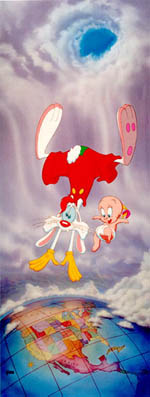
![]() Some versions, including the television version shown on Fox, have an extra
scene: Eddie Valiant had gone into Toontown, ambushed by the weasels and
had a pig's head "tooned" onto his. He went home and took a shower during
which Jessica walks into his apartment.
Some versions, including the television version shown on Fox, have an extra
scene: Eddie Valiant had gone into Toontown, ambushed by the weasels and
had a pig's head "tooned" onto his. He went home and took a shower during
which Jessica walks into his apartment.
![]() Benny the Cab
drives across a bridge while being pursued by the Weasels. The bridge used
crosses the freeway that runs by the Walt Disney Studios lot on Buena Vista
Ave, in Burbank.
Benny the Cab
drives across a bridge while being pursued by the Weasels. The bridge used
crosses the freeway that runs by the Walt Disney Studios lot on Buena Vista
Ave, in Burbank.
![]() Some versions
have an extra scene: Eddie Valiant had gone into Toontown, ambushed by
the weasels and had a pig's head "tooned" onto his. He went home and took
a shower during which Jessica walks into his apartment. This scene was
cut from the original release, but did appear in theatrical trailers and
a television broadcast.
Some versions
have an extra scene: Eddie Valiant had gone into Toontown, ambushed by
the weasels and had a pig's head "tooned" onto his. He went home and took
a shower during which Jessica walks into his apartment. This scene was
cut from the original release, but did appear in theatrical trailers and
a television broadcast.
![]() Eddie enters
a Toontown men's room which has the graffiti "For a Good Time, call Allyson
Wonderland" in the background.
Eddie enters
a Toontown men's room which has the graffiti "For a Good Time, call Allyson
Wonderland" in the background.
![]() Judge Doom picks
up a record and reads its label: "The Merry-Go-Round Broke Down," then
says, "a looney tune for drunkards." The song "The Merry-Go-Round Broke
Down" is the familiar theme song for the Looney Tunes cartoons.
Judge Doom picks
up a record and reads its label: "The Merry-Go-Round Broke Down," then
says, "a looney tune for drunkards." The song "The Merry-Go-Round Broke
Down" is the familiar theme song for the Looney Tunes cartoons.
![]() An assistant
director is visible in the reflection in the trolley car window as Eddie
leaves the studio lot after his first visit to Maroon's office.
An assistant
director is visible in the reflection in the trolley car window as Eddie
leaves the studio lot after his first visit to Maroon's office.
![]() When the weasels
are cutting through the back wall of the ACME, a brick can be seen hovering
in the air unsupported.
When the weasels
are cutting through the back wall of the ACME, a brick can be seen hovering
in the air unsupported.
![]() Right after Eddie
has arrived in Toontown, he heads to the hotel, where he thinks Jessica
Rabbit is at. After abruptly exiting the elevator, look at the wall paper
to the side of Eddie. The design pattern consists of the dancing thistles,
from "The Nutcracker Suite" sequence, in Fantasia.
Right after Eddie
has arrived in Toontown, he heads to the hotel, where he thinks Jessica
Rabbit is at. After abruptly exiting the elevator, look at the wall paper
to the side of Eddie. The design pattern consists of the dancing thistles,
from "The Nutcracker Suite" sequence, in Fantasia.
![]() When Eddie and
Roger are hiding in a theater, they are watching a Goofy cartoon entitled
"Goofy Gymnastics." This cartoon was released in 1949. But, the film's
storyline takes place in 1947.
When Eddie and
Roger are hiding in a theater, they are watching a Goofy cartoon entitled
"Goofy Gymnastics." This cartoon was released in 1949. But, the film's
storyline takes place in 1947.
![]() Set in 1947,
features the Singing Sword bearing the likeness of Frank Sinatra that croons
several bars of the Coleman-Leigh song "Witchcraft," which wasn't written,
and which Sinatra didn't record, until 1957.
Set in 1947,
features the Singing Sword bearing the likeness of Frank Sinatra that croons
several bars of the Coleman-Leigh song "Witchcraft," which wasn't written,
and which Sinatra didn't record, until 1957.
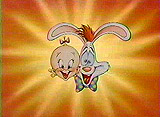 |
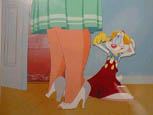 |
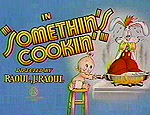 |
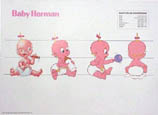 |
By Jim Hill
Roger Rabbit started on the road to screen stardom away back in 1980, when then-Disney Studio head Ron Miller got a hold of the galley proofs for a soon-to-be-published novel, Gary Wolf's "Who Censored Roger Rabbit." He brought the story to the attention of then-Disney CEO Card Walker, who found the novel weird and dark and told Ron to pass on the project.
But he didn't, and over Walker's objections, Ron Miller paid $25,000 for the film rights to the book, then handed the project off to a young Disney production executive, Mark Sturdivant, for development, and had him approach Warner Brothers, Paramount and Universal about contracting their classic cartoon characters out to appear in Who Framed Roger Rabbit. They all just laughed, said no and/or asked for such ridiculously high fees that they made making a deal impossible.
In spite of the setback, Ron Miller remained determined to get this film made. He sent test footage as well as the Roger Rabbit script to Steve Spielberg, Robert Zemekis and Joe Dante for their review. Each of these directors was intrigued by the project, but they also doubted that tired old Disney Studios had what it took to get this sort of special effects extravaganza off the ground. Miller offered to put up a budget of $25 million. All three directors still passed on the picture.
Even in the face of these high profile rejections, Miller still pressed ahead with his plans for a Roger Rabbit feature. He kept faith in the project right up until September of 1984, when the Walt Disney Company suddenly lost faith in him. That's when Miller was unceremoniously forced out and Michael Eisner became the Big Cheese at the Mouse Factory.
In 1986, after being on board at Disney for a year and having quickly thrown together a few live action films like Down and Out in Beverly Hills and Ruthless People that made money for the company, Michael Eisner was anxious to do something more ambitious, an event film with a huge budget and tons of special effects that could win awards as well as offer lots of opportunities to generate cash for the company. Then-Disney Studio head Jeffrey Katzenberg uncovered just such a project one day while reading through some old scripts Disney had previously put into development. Way down deep in the pile, he discovered the latest screenplay for Who Framed Roger Rabbit? Eisner immediately realizes that this was the film he was looking for.
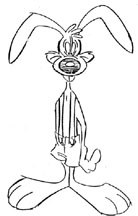 The
only stumbling blocking for Michael Eisner and the revived Roger Rabbit
project was the same thing that tripped up Ron Miller: getting the clearances
from all those other Hollywood studios for use of their classic cartoon
characters. Without those non-Disney 1940s-era toons for Eddie to interact
with, Roger Rabbit would just fall flat.
The
only stumbling blocking for Michael Eisner and the revived Roger Rabbit
project was the same thing that tripped up Ron Miller: getting the clearances
from all those other Hollywood studios for use of their classic cartoon
characters. Without those non-Disney 1940s-era toons for Eddie to interact
with, Roger Rabbit would just fall flat.
But Eisner had a secret weapon: his personal and professional relationship with movie maestro Steven Spielberg. He proposed that Disney and Amblin produced Who Framed Roger Rabbit? together. Disney would lend its animation expertise to the project. Steven would bring in his buddy, George Lucas and his wizards at ILM to handle the film's special effects. More importantly, Spielberg could use his considerable clout to persuade the other Hollywood studios to allow the Mouse to use their classic cartoon characters. Steven was willing to take Uncle Mikey on his offer--with one condition: Disney and Amblin had to share the copyright on any characters that were created for the film. That included merchandising revenues, sequel and spin-off rights. Eisner was so desperate to get his event film made that he quickly agreed to Spielberg's terms.
The actual production of Who Framed Roger Rabbit? is a classic Hollywood horror story. A troubled film right from the start, its budget started at $30 million, then quickly escalated to $50.6 million. The one aspect of the project that did not go over-budget was the licensing deals Spielberg worked out for use of the non-Disney classic cartoon characters to be featured in the film. True to his word, Spielberg persuaded the other Hollywood studios to lease their toons to the Mouse for a ridiculously low fee: $5000 per character.
Work on the movie fell so far behind schedule that--in February 1988--it looked Roger Rabbit might miss its June 24th opening date. Since Disney had already signed multi-million dollar promotional deals with McDonalds and Coca Cola that keyed on Roger Rabbit opening on that day, missing the film's opening date was not an option. So Uncle Mikey forced then-Disney studio head Jeffrey Katzenberg to personally take charge of the project. Jeffrey did everything he could think of--kicked, cried, screamed, cajoled--to get the Roger Rabbit team into meeting their production deadline.
With Katzenberg cracking the whip, Who Framed Roger Rabbit? did
actually make it into theaters on June 24th. The film immediately became
a box office sensation--grossing over $154 million in its initial domestic
release alone. Overseas, Roger Rabbit was even more popular, taking in
$174 million at the international box office.
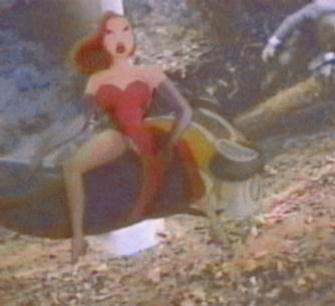 |
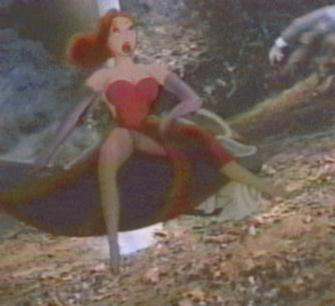 |
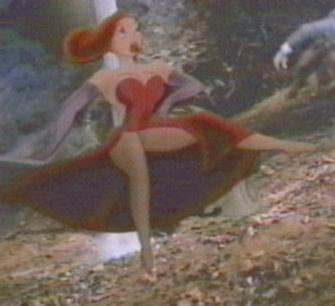 |
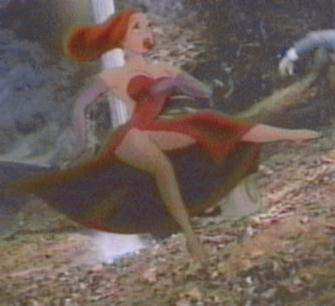 |
WILL THERE BE ANOTHER ROGER MOVIE?
The chances of there ever being a Roger Rabbit prequel or sequel are slim to nil. While talking to columnist Liz Smith on April 24, 2000, producer-writer-director Frank Marshall set the record straight on how the project stands, saying, "After we budgeted the project, we realized it would simply be too expensive -- way, way too expensive. The first Roger Rabbit only had 40 minutes of animation. The second ["Toon Platoon", a prequel entirely set in Roger's native Toontown] was going to have twice that much." Marshall also noted that the first film's budget was $50M, quite a bit at the time, adding, "that was nearly 15 years ago. Today, its cost would be prohibitive."
While producer Frank Marshall claims that rising animation costs have permanently torpedoed the practicality of doing a sequel, the bazillions of semolians to be reaped in merchandise, tee-shirts, books, burger joint tie-ins and other venues, make this statement seem like a load of succotash. Figuring that Roger is a known, and well-liked character there would be built-in interest to see him in another flick, and even considering the inflated SPFX budget, the film would kill at the box office.
The real reason why another Roger Rabbit is unlikely to ever see the light of day is other: bad blood between Dreamworks and Disney. Since the Mouse House and Steven Spielberg's Amblin own half of the copyright on the characters created for Who Framed Roger Rabbit?, both sides have to agree exactly on the terms of the contract every time Roger appears in a film or a theme park attraction or even on a toy. Back in 1989, both Disney and Spielberg were anxious to cash in on the first film's popularity: the director okayed the production of Disney's first Roger Rabbit short Tummy Trouble.
The Mouse quickly cut a deal with Spielberg to co-produce a sequel to
the first film, before announcing that they'd be following up Tummy
Trouble with a whole new series of Roger Rabbit shorts. But the next
installment, Roller Coaster Rabbit, started all the problems. Spielberg
wanted the second short to be shown in front of Amblin's Arachnophobia,
while Disney preferred and ended up attaching it instead to copies of its
own Dick Tracy.
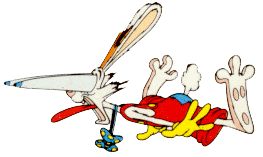
In the light of Arachnophobia's disappointing box-office results,
Steven Spielberg--a man used to getting what he wants--was upset and, as
a co-owner of Roger Rabbit, felt that he should have had more of a say
in how the character was being used, particularly concerning which short
got put in front of which movie. So he decided to make his position regarding
Roger Rabbit and Disney clear. He waited 'til Disney actually had a new
short, Hare in My Soup, in production. Then Spielberg announced
"I don't like the story for the new short. Without my approval, you can't
go forward with this film. Shut down production."
Given that these were indeed the terms of the Roger Rabbit deal, Disney reluctantly halted work on Hare in My Soup. None of the other story ideas for shorts the Mouse pitched to Spielberg met his fancy either. It would be two years before Spielberg would allow work to proceed on a new Roger Rabbit short, Trail Mix-Up. By then, Steven was also holding up production on a proposed prequel to the original feature film, Who Discovered Roger Rabbit?, which dealt with Roger's early days as he struggled to make it as a star, his courtship of Jessica and the search for his long-lost mother.
One of the last drafts written of the proposed Roger prequel is similar to Cats Don't Dance (a rags-to-riches Hollywood song n' dance tale) with liberal dashes of The Jerk and Stuart Little thrown in for flavor. Basically, Roger is a toon rabbit adopted by a human family on a midwestern farm. He puts an act together with his human "brother" and they hit the road to take Hollywood by storm. Once they get to the big town the brother becomes a star and forgets Roger, who is relegated to the company of toons. There is a happy reunion of course, and the big novelty this time seemed to be the mixing in of classic film stars (Gable, Bogart, etc.) the way toon guest stars were used in the first film. Whether these would be contemporary actors recreating the classic stars or the stars themselves digitally colorized and processed in was not clear from the script, but given some of the ligitimate concerns over cost (and there probably were scads) the latter seems most likely.
Sherri Stoner and Deanna Oliver's version of Who Discovered Roger Rabbit? (which for a short time was considered as a direct-to-video project) was a funny and affectionate tribute to those old movie musicals that impressed a lot of people at Disney. In fact, someone liked the screenplay so much that they slipped a copy to Disney's house composer, Alan Menken. Menken was so impressed with what he read that in addition to writing five songs for the film, he signed on as executive producer.
This brings us up to 1997. The Mouse is anxious to finally get production underway on their Roger Rabbit prequel. But by then, Jeffrey Katzenberg, who splitted with Disney three years earlier, worked with Spielberg at Dreamworks SKG. Given Jeffrey's animosity toward Disney in general (and Eisner in particular), Michael worries that Katzenberg could deliberately bad-mouth the project, compelling Spielberg to pull the plug on the prequel. Furthermore, the Mouse House was loathe to make a deal with their new rivals in the toon game. The last thing Disney wants to do is write a couple of fat checks for Steven and Jeffrey for their profit participation in a Roger sequel, and that is exactly what they'd have to do. Also, that would mean Jeffrey would once again have creative input into Disney animation, which would most likely tick off Mr. Eisner no end. Neither party is willing to give in to the other, and so we have the Toontown version of the Mexican stand-off.
Still, Michael Eisner tricked Spielberg into keeping his mouth shut and allowing pre-production work to proceed on Who Discovered Rogert Rabbit? by recruiting two of his long-time Amblin associates and friends--Frank Marshall and Kathleen Kennedy--to serve as producers on the Roger Rabbit prequel.
Test footage to see whether new animation techniques could keep costs down quietly went underway in the spring of 1998 at Disney Feature Animation in Florida. Master animator Eric Goldberg put together a new model sheet for the wacky rabbit, making Roger younger looking as well as easier-to-draw. While computer generated props didn't mesh well with more traditionally animated characters, a second production test with CG characters was met with a lot of enthusiasm--until Michael Eisner learned that it would drive the cost of the Roger Rabbit prequel well north of the $100 million mark. As soon as he heard that, Uncle Mikey pulled the plug on the project.
Since then, the box-office failure of both Monkeybone and The Adventures of Rocky and Bullwinkle did not help reviving the project. A couple of months ago, producer Frank Marshall said that the movie had been "so much work" that there were no plans to do a sequel or a prequel, or even produce new Roger Rabbit animated shorts.
Nevertheless, producer Frank Marshall gave hopes to fans in February 2002: "We developed a script for Roger 2, which was sort of a prequel. [It showed] how Roger came to Hollywood, but it was too expensive. When we laid it all out, there was too much animation and it was too expensive. But now that things are what they are with CG, we may look at it again. But it’s pretty dormant right now."
But eight months later, as he was announcing the release of a 2-disc
Vista Series edition for the blockbuster, the same Frank Marshall, who
also directed parts of the three Roger Rabbit theatrical cartoon
shorts, said the movie was so much work that if the filmmakers knew in
advance how hard it turned out to be, they might never have made it. That
is why, he added to Variety, there are no plans to do a sequel or a prequel,
or even produce new Roger Rabbit animated shorts. "I think the movie sort
of stands on its own,. I think it's kind of like E.T. for all of
us; everybody came together at the right point of their careers."
INTERVIEWS WITH CREATOR GARY WOLF
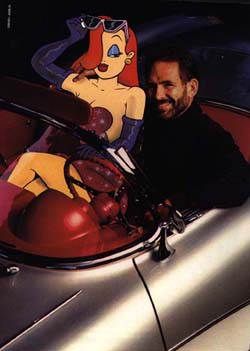 Below
are transcripts of two Internet chats (one from 1995
and the other from 1997) with Mr. Gary Wolf, father
of Toontown and writer/creator of Roger Rabbit and Jessica Rabbit.
Below
are transcripts of two Internet chats (one from 1995
and the other from 1997) with Mr. Gary Wolf, father
of Toontown and writer/creator of Roger Rabbit and Jessica Rabbit.
As the celebrated author of the novel "Who Censored Roger Rabbit?," Wolf gained fame in 1988 when his literary vision of humans cohabitating with animated characters became a reality in the $750 million blockbuster Disney/Spielberg film "Who Framed Roger Rabbit?". The film won four Academy Awards and launched a multiple-picture screen writing deal for Wolf with Walt Disney Pictures. In addition, his ideas inspired Toontown, the newest themed land at Disneyland, Tokyo Disneyland, and Walt Disney World's Magic Kingdom.
After graduating from the University of Illinois with a Masters degree in advertising, Wolf began his career as an advertising executive for a San Francisco advertising agency. He then switched coasts and moved East where he worked as vice president and creative director for several more advertising agencies. He is now a full-time writer living in Boston.
Among his writing credits are the novels "Who Censored Roger Rabbit?",
"Who P-P-Plugged Roger Rabbit?", "The Late Great Show," and his current
novel, "The Urban Jungle Book;" the feature films "Who Framed Roger Rabbit?"
and the Roger Rabbit sequel feature in production, "The Flying Tigerfish,"
"Typhoon Lagoon," "The Curse of Cali Caliph," and "Genie Man;" the animated
shorts "Tummy Trouble," "Roller Coaster Rabbit," and "Trail Mix-up;" plus
numerous short story anthologies.
Q: How does the film compare to your original idea of Rogert Rabbit?
The film and my original idea are perfectly mated. I participated all along in the production of the movie. That's very unusual in Hollywood, for a writer to be involved, but Roger Rabbit was a very unusual project. Everybody associated with it really wanted to make it the best movie it could possibly be. There were times when I sat in rooms with 50 of the most creative people in the film business kicking around jokes to include in the movie. Of course, the plot line and some of the toon conventions had to change because I wrote a book and this was a movie, but the changes were all within the context of my original premise I.e. a world where cartoons were real. I've got no complaints.
Q: Why have there been delays in a new movie?
The delays with movie two have all involved the creative process. We want to make Roger II unique. That's not easy. We've been very close many times, but someone has always come up with something that might be better, and the project direction changed. This is very typcial of the way movies, especially innovative movies, get made. The miracle is that Roger I ever saw the light of day.
Q: In today's politically correct environment, do you think a movie/short version of Roger Rabbit could remain as free-wheeling as he was in the original full-length movie?
Oh, sure. Cartoons have always existed in a realm of there own. Cartoons were invented to poke fun at political correctness. The in jokes and the subtle humor are Roger trademarks, and nobody has every suggested taking them out.
Q: Are any more Roger shorts planned?
No more Roger short planned for the near future, but that could change at any time. The plan now is to release the three current ones on video.
Q: Were you involved with the creation of Toontown?
I participated in the planning for all of Toontown and rode the car toon spin ride many, many months before it officially opened. I think it's the best dark ride I've ever been on. The illusions are superb. And it has a story line. It's the only ride at DL in which it's actually a pleasure to wait in line. Like so many other things about Roger, there are hidden things throughout. Look closely, and you'll be amused.
Q: How many shorts have there been?
There have been three Roger Rabbit shorts--Tummy Trouble which showed with Honey I Shrunk the Kids, Roller Coaster Rabbit which showed with Dick Tracy, and Trail Mix Up which showed with Amblin's A Far Off Place. Roller Coaster is one of the funniest cartoons I've ever seen this side of Tex Avery.
Q: Is the new movie going to feature as many third party cartoon characters as the old one, specifically the Warner Bros. more current characters?
Hard to tell if the new movie will have as many Warner Brothers characters. Remember, when we did Roger, nobody was doing this kind of film. There was really not much call for Bugs and Daffy in a major motion picture. Now everybody is doing it. Hard to say how that will impact our stars. I can say that Bugs has a tough agent. He and Mickey had to appear on screen for the exact same amount of time, they had to be in every scene together, and they had to have exactly the same number of words of dialog.
Q: It appeared that Mickey was on just a fraction longer.
If you rent the laser disk version of the film, the non-letter-boxed version, notice how the scene with Mickey and Bugs was cropped. Guess who did the cropping!
Q: Have there been talks with Disney regarding the third book?
The third book, Roger Rabbit's Gossipy Guide to Toontown, will be a a graphic novel. It will be illustrated with photos which Roger has taken himself. They will all be in black and white and will pasted into the book like in an old-style photo album. In the story, Roger takes Gary Cooper on a guided tour of Toontown. In the process, they uncover a murder. Coop and Roger combine to solve it. The only negotiations thus far with Disney involve the approval processes for the artwork. That's a done deal. As I say, the book will be published when movie II comes out.
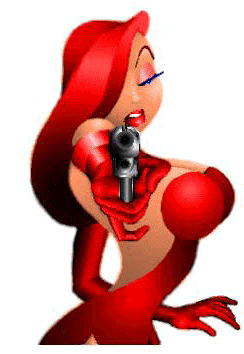 Q:
Is Jessica Rabbit an ideal woman creation of yours, or is she based on
any one or multiple women?
Q:
Is Jessica Rabbit an ideal woman creation of yours, or is she based on
any one or multiple women?
Jessica Rabbit is my idea of the perfect woman. But you must remember that I was an only child, no sisters, and grew up in a small mid-western town with no girls. The only women I knew were elderly school teachers and maiden aunts. So I invented Jessica to by. I based her on Tex Avery's Red Hot Riding Hood. In fact, if you watch that cartoon, you'll see RHRH doing a musical number which is a virtualy dupolicate of the one Jessica does in the Ink and Paint Club. Incidentally, because of my lack of understanding of women, I have been advised more than once to limit my writing to war stories and Turkish Prison movies.
Q: Which character do you feel he is most like or that he can most relate to?
Roger Rabbit is actually autobiographical. Roger is the essence of fun and good humor. Eddie is the soul of logic and by-the-book methodology. Together they make up one good person. I see them both as me. Incidentally, I named Roger after my only male cousin and Eddie after my father.
Q: Okay, then, what about the infamous nude scene?
The nude scene! I thought you'd never ask. The animators wanted to do an homage to Fleisher's Betty Boop. He had her topless in every movie, for six frames, invisible to the human eye. So they did the same with her in Roger Rabbit. When we decided to release the film on video, the producer went on Johnny Carson and spilled the beans. So we were forced to take it out. However, there are numerous other "spicy" numbers which remain. You'll have to find them yourself. But one of them involves Michael E's home phone number. And of course, the most famous shows Jessica sans underwear (not that she needs any, but hey it's the thought that counts)
Q: Do you know if, when Roger Rabbit II is released, there will be plush merchandise for the supporting characters? For example, Jessica?
For sure there will be plush merchandise on the main characters. It's hard to tell what kinds of merchandise will be available for Jessica. She's a tough one for Disney to merchandise. She's clearly more adult than Pocahantas (although they're shaped surprisingly similarly). Disney had The Jessica Store at Pleasure Island at WDW where they sold all kinds of Jessica merchandise. Including the best ever jessica watch. I've never seen a Jessica plush. Probably never will be. Too many guys might mistake it for a Jessica inflatable.
Q: Did you write instructions to leave a few frames uncolored so Jessica would be "nude/pantyless"? What part of Jessica did you think up first?
The animators did the animation all on their own. Of course, everybody knew what they were doing and approved of it heartily. It was so in keeping with the premise. Jessica came to me full blown in a dream. A very good dream, if you must know.
Q: Did you have any say or input when they were looking for the voice actor for Roger Rabbit or the other characters?
When we were looking for a voice actor for Roger, Bob Z suggested a stand up comic he'd heard in L.A. That was Charlie Fleischer. I went to hear him with a number of the Disney Production staff. We all felt he was right. We called him in and he gave us a reading. He got the job immediately. He and I worked with the animators to perfect Roger's voice. Dick Williams felt that every truly great cartoon character had a speech impediment. We tried lisps, quacks, and a bunch of other stuff. Charlie came up with the stuttered P. After he did it a few times, we knew that was it. The other voices we tried to keep true to the originals. Mel Blanc did as many as he could, but was in very bad health and couldn't do Yosemite Sam. Roger turned out to be his last role.
Q: Did you approach Disney with the idea of Roger Rabbit, or did they come to you looking to do a new type animated feature?
Disney came to me. Somebody at my publishing house (I've tried to find out who so I could kiss him or her full on the lips) photocopied a copy of my book and surreptiously sent it to Disney. They read it and called my agent. He was as surprised as I was. I actually never thought anybody would invest the time, talent, and money in the project to do it right.
Q: Were the examples of the topless Betty Boop, and other nude things you were talking about planned?
No, the hidden stuff was not planned. Like so much of what happens extemporaneously in a great movie, they just sort of happend, and added to the ambience.
Q: Now that Disney is bringing back Mickey Mouse in a new cartoon ("Runaway Brain") -- do you think teaming up Mickey and Roger Rabbit has possilities, sort of like Stan Laurel and Oliver Hardy?
Teaming up Mickey and Roger as Stan and Laurel certainly has possiblities. However, I think a better teaming is Roger and Bugs in a Lethal Weapon-type movie. Roger is the frantic one, Bugs is the brains. We've suggested it to Warner Brothers.
Q: How has WB received the Roger/Bugs idea?
They're still considering it. They've been looking for a starring vehicle for Bugs ever since RR came out. Like I said earlier, nothing in the movie business gets done at anything faster than slow glacier speed.
Q: When did you first get the idea for Roger Rabbit?
I had written three well-reviewed science fiction novels. They sold well as science fiction goes. They were all nominated for major awards. I figured since I wasn't making any money at writing anyway, I might as well write I got the idea for Roger something I really enjoy based on my two favorite subjects, film noir mysteries and cartoons/comic books/comic strips. When I was searching for a premise on which to hang the story, I was watching Saturday Morning cartoon strips. Purely research, mind you. I saw the Trix rabbit, Captain Crunch, Snap Crack and Pop, cartoon characters talking to real kids, and nobody seemed to think that was strange. That was it. I thought, what would a world be like if cartoon characters were real. I worked on the first Roger novel from 1971 until 1980. When I sent it to my published, Doubleday, they rejected it. Their reason?
They said nobody would understand it. I had never had a reject in my life. I started sending it to other publishers. It got rejected 110 times by actual count until St. Martins took a flyer on it. At last count, it was in its 14th printing, more than 1 billion people have seen it in the theaters, and there hasn't been one complaint from anybody that they couldn't understand it. A real tribute to the stupidity of the publishing industry and the intelligence of the average reader/movie goer.
Q: When writing the first novel, did you envision it to be a movie or just a novel... I.e. putting in special nuances that are designed for a film environment?
I never thought the first novel would be anything but a novel. And that's the way I wrote it. If you write things in one mileau with the intention of having them appear in another mileau, you're asking for a weak book. I always write books as books and movies as movies. That's why I've been so reluctant to translate one of my own books into a movie. I'm too close to it.
Q: What bits were left out of Who Framed Roger Rabbit and the shorts that you felt should have gone in? In other words, what got edited out?
Nothing got edited out of the shorts. They appeared exactly as intended. The pig scene got cut from the movie. We really didn't know wether this would be an adult movie or a kids movie. A kids movie has to run around 90 minutes, so we had to cut it to somewhere close to that. By cutting the pig scene, we eliminate some of the mystery surrounding Jessica. it also causes a bit of a problem when Eddie comes out of his bathroom soaking wet wearing his underwear for no apparent reason. This scene was re-inserted when the film showed on TV.
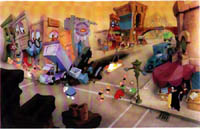 Q:
How much do you think Disneyland's "toontown" is a result of Roger Rabbit?
Do you feel any credit to you is due?
Q:
How much do you think Disneyland's "toontown" is a result of Roger Rabbit?
Do you feel any credit to you is due?
I think toontown is a direct result of Roger Rabbit. Naturally, I feel a sense of pride and accomplishment whenever I walk through it. It's like taking a trip through my own imagination. Like I said earlier, I'm a happy guy. I don't a bitch in the world with Disney. I'm probably the only writer in the world who's been treated fairly and whose ideas have been translated accurately to film.
Q: So these RR books are still out there?
Who Censored is still available in paperback. Ballantyne. Who Plugged only came out in hardcover. For some unknown reason, the publisher (Villard) never sold the paperback rights. It's long out of print. Now goes for fifty bucks if you can find one. An oridinal hardcover Who Censored (which features me on the cover as Eddie Valiant) goes for many hundres of simoleons if you can find one.
Q: Pig scene?
Pig scene--The weasels capture Eddie. They take him into Toontown where Doom and Jessica interrogate him. You get the feeling they're in it together. The Weasels take him back out to L.A. and dump him. He has a big animated pig's head on him. He says I've been pigged. It's actually in the previews, though not in the film. He goes back to his apartment and washes it off in the shower.
Q: Doesn't Eddie always shower in his underwear so he doesn't have to use the laundromat?
Probably. I know I do.
Q: Has Disney approached you about any Florida projects based on Roger Rabbit?
Toontown was originally scheduled to become a WDW attraction, but as you probably know it's now scheduled for Tokyo first instead. Scheduled to open there April 19, 1996. Still right on target.
Q: What other cartoons are lurking in your imagination that we haven't seen yet?
I've just finished my sixth novel called Typical Day. It takes me back
to my days of science fiction. Should be out next year. I just finished
a new science fiction movie which may be out in two years. I don't get
involved in the shorts, at least not in the story lines.
Wednesday
6 August, 1997
The Arbordale Auditorium on
AmberThree Productions' EntertainMuck
Q: Is Eddie going to be in the newest RR feature.
Eddie will be in a future sequel. Disney bought the rights to my Roger Rabbit sequel novel "Who P-p-p-plugged Roger Rabbit". Note, we've standardized on the six P stutter. That one takes the story forward from the end of the last movie."
Q: Is that the one being worked on now?
The actual sequel currently in production is a prequel. It's set before Roger met Eddie, so Eddie can't be in it.
Q: How is that one coming along?
It's coming along very well. It was going to be a direct to video release on the order of the Aladdin sequel. But the story idea is so great it's going to be a full length theatrical feature instead.
Q: Have you heard the music that's being done for it?
There are some things which have to be kept quiet in Toontown, and the Roger Rabbit music is one of them. I'm not allowed to say. But if you lean in closely, I'll hum a few bars.
Q: It's been rumored that Alan Menken is writing for it, so I'm sorry you can't comment!
I'm sorry too. In my frequent conversations with him, he seems like a very talented composer. For a guy who composes on the harmonica.
Q: Do you feel more satisfaction seeing your written work on the shelf in a bookstore, or your creations adapted for the movie screen, be it an actual airing or a video at a rental store? Why?
It's a toss up. The two sensations are very different. I feel more satisfaction from the book because it's totally my creation. But so many more people have seen and enjoyed the movie, and know my work from that rather than from the written page, that I can't help but feel a sense of pride in the film and video versions as well.
Q: Will 'WP-P-P-PRR' have the same vast (or half-vast) cast of toons 'WFRR' did?
Even half vaster. I've invented a whole bunch of new characters. Including Joellyn, Jessica's twin sister. Although they look the same, Joellyn is only three and a half inches high. Eddie carries her around in his pocket. They have a love affair -which was a real creative challenge to write.
Q: Will WP-P-P-PRR and the prequel movie still mix existing Disney characters with other non-Disney Studios characters? Like Warner Brothers ones?
Yes. It's become a tradition. Droopy has been in all of the Roger cartoons. I think I can safely say that there will be other studio characters in the sequel. In fact, Roger's a bit miffed that he wasn't asked by Warner Brothers to play left out on the Space Jam team.
Q: Are there any more 'Tales from Toontown' to be told? Any more books you're working on?
I have another book already finished. It's called "Roger Rabbit's Gossipy Guide to Toontown." It's like Hollywood Babylon with a plot.
Q: When will it be out? And when will the prequel movie in production come out?
The new book will come out when the movie comes out. Probably not in this millenium, unfortunately.
Q: Are there any more Roger Rabbit cartoons coming out?
Hard to say. They're very expensive and time consuming. Although they do contribute to the audience of whatever film they're matched with.
Q: Why is the new Roger Rabbit movie taking so long to make?
The first movie took from 1980 until 1988. This one was started
in 1992, so it's pretty much on schedule, as Toon projects
go.
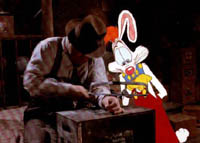 Q:
Is Bob Hoskins going to be in the sequel?
Q:
Is Bob Hoskins going to be in the sequel?
Not the one in production, but the one after that. He will be in the sequel, but not the prequel.
Q: Who's in the next movie?
Hasn't been cast yet. We're talking to a few very big names, although I don't think big names are really necessary. Hoskins wasn't that well known when he did it, and he made the movie what it was.
Q: How about Charles Fleischer? Will he be in it as the voice of Roger again?
Charlie is the voice and always will be. Nobody does it better.
Q: How did Charles Fleischer get chosen as the voice of Roger Rabbit?
We heard him performing at a comedy club in L.A. He's the funniest comedian I've ever heard. His act included a number of voices. We had him come in for a reading. We never even considered anybody else. The feeling was that all great cartoon characters had a speech impediment. Charlie tried a lisp, a slobber, etc and finally came up with the stuttered P. That wasn't in my book, but it works perfectly.
Q: Is what he did what you had in mind?
When I shut my eyes and heard the rabbit while I was writing him, I heard what Charlie did. The man's a genius.
Q: Any chance some of the newest animated characters will appear? Like Ren & Stimpy, for instance?
We limited the characters to those created before 1946, the year the movie was set. Ren and Stimpy, The Flintstones, etc. came out years later. Only two exceptions. The Roadrunner and Wiley Coyote -Bob Z's favorite characters. They appear as silhouettes in the elevator with Droopy. You'll need a good freeze frame to see them. Hidden secrets of the movie biz.
Q: Speaking of hidden things, what's the deal on the Jessica Rabbit cels that show a bit more than others?
I can't officially confirm that, but if I had to guess, I would say that it was the animators continuing an age-old tradition. Betty Boop was topless in six frames of every cartoon. If Betty can boop a doop, so can Jessica. If you actually see the scene, there's nothing really risque-like about it. It's the equivalent of peeking under the skirt of your Barbie doll. Animation is a very tedious business. Whatever animators can do to keep themselves enthusiastic, more power to them.
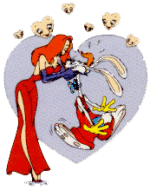 Q:
How did you come up with the idea of Jessica Rabbit?
Q:
How did you come up with the idea of Jessica Rabbit?
She's based on a Tex Avery character call Red Hot Riding Hood.
Red Hot appeared in a number of cartoons in the forties and early fifties.
Wild and Woolfy being the one I remember best. While we're on the
subject, let me answer one of my
most frequently answered questions: what are Jessica's measurements?
Outrageous - itty bitty - va va voom. Nuf said!
Q: What do you think about the Toontown "lands" made at the Disney parks?
It's like walking through my own imagination. Very interactive places. When you go, stand on a manhole cover. Sometimes they talk to you. And notice the copy of Jessica's Secret lingerie catalog on Minnie's armchair. We have them in California and Tokyo There's a watered-down version in WDW's Magic Kingdom now, too.
Q: What did you have to do in the making of Toontown at Disneyland?
Again, Disney treated me well. I was consulted on the major aspects of the project as it went along. I got to go out to California and see the preliminary designs. I watched it being built. And I went to the opening party which was the best party I've ever been to in Hollywood.
Q: How do you think Disneyland's Toontown compares to your idea of it? How do you like how it came out?
It is exactly as I envisioned it. Very tough place to build. There are no right angles anywhere. It had to built as a model and then scaled up. They tell me it's the most successful themed land they've ever had.
Q: How important has it been, in your experience as a writer, to be represented by an agent? Have you used an agent at all?
Extremely important. These days you can't sell a book or a screenplay without one. When I first started, you could always sell a novel yourself if you were persistent. But now that the big book chains have more control over publishing, it's imperative to have an agent who really knows the market. I'm lucky. I've had the same agent my entire career. That's very unusual. Most writers change them more often then they change their underwear.
Q: If there really was a Toontown, would you want to live there?
I DO live there already. It's one of the advantages of having a hyperactive imagination. Seriously, one of the hardest things about writing a Roger novel is putting yourself into Toontown everyday and imagining what it would be like to live there. If you go into a bar, is it a Toon bar, a human bar... Will they serve Toons liquor and if they do, what happens?
Q: What do you do to get in the mood? Watch more cartoons, like you started off doing?
Not anymore. I'm so familiar with Roger and his friends that I can slip in and out pretty much at will.
Q: Is Roger Rabbit your favorite Toon character?
I'd have to say yes. The novel was autobiographical. Roger and Eddie together make up one good person. Roger is all fun and games, Eddie is all hard knocks and logic.
Q: What's your most and least favorite questions about 'WFRR'?
Least, 'How come the Simpsons weren't in it?' And maybe 'How much money did you make? Most, 'Did you like the result?' Incidentally, you must be a journalist. That's a question which nobody has ever asked me before, a rarity.
Q: What have you heard about plush merchandise when the new movie comes out?
There will be some. Right now, it is almost impossible to find a Roger doll. Write Michael Eisner and complain!
Q: How about a Jessica plush? Will there be one?
I think they had an inflatable on the drawing boards but the idea blew up. Sorry.
Q: Do they sell Roger stuff in Tokyo? Other stuff than here?
I have never seen a piece of Roger merchandise from Tokyo. Strange, since they do have Roger as a major presence in Toontown. The big sources for Roger merchandise these days are WDW and Disneyland. And the Ice Capades still sells it.
Q: What's the story line to the sequel?
It's a closely guarded secret, but it involves Roger's upbringing and his trip to L.A. to find the mother who abandoned him as a bunny. There he meets Jessica, Baby Herman, and breaks into showbiz. Plus has a lot of goofy adventures.
Q: Do you think you have created a kind of Toon 'universe' (Tooniverse?) because of your work?
No question. When I sold the rights to Roger to Disney, there was no place else I could have sold them. As a result of Roger, every major studio now produces animated features. Roger revolutionzed and rejuvenated an industry. I'm almost prouder of that than of the fact that I coined the word Toon.
Q: Did you ever to into a Disney park and hang around with the Roger walkaround character?
I can't answer that because the Roger character who let me wear the costume (if, indeed, I did wear the costume which I'm not admitting) would get into a p-p-p-parcel of trouble. If I had done it, I think it would have been the greatest theme park experience of my life, actually becoming my own character.
Q: Do you ever check out the Roger Rabbit sites on the Web? What do you think of what your fans have done to honor you on web sites?
I do from time to time, but there are now so many, that it's hard to keep up. I'm really tickled when anybody makes mention of me on the web. I'm still a small town boy at heart. It's hard for me to deal with fame.
Q: Did you expect your first novel to be the movie hit it turned out to be?
Never in my wildest dreams. It was more than I ever hoped it would
be. In that regard, I'm lucky. I could have been the guy who
did Howard the Duck!
|
||||||||||||